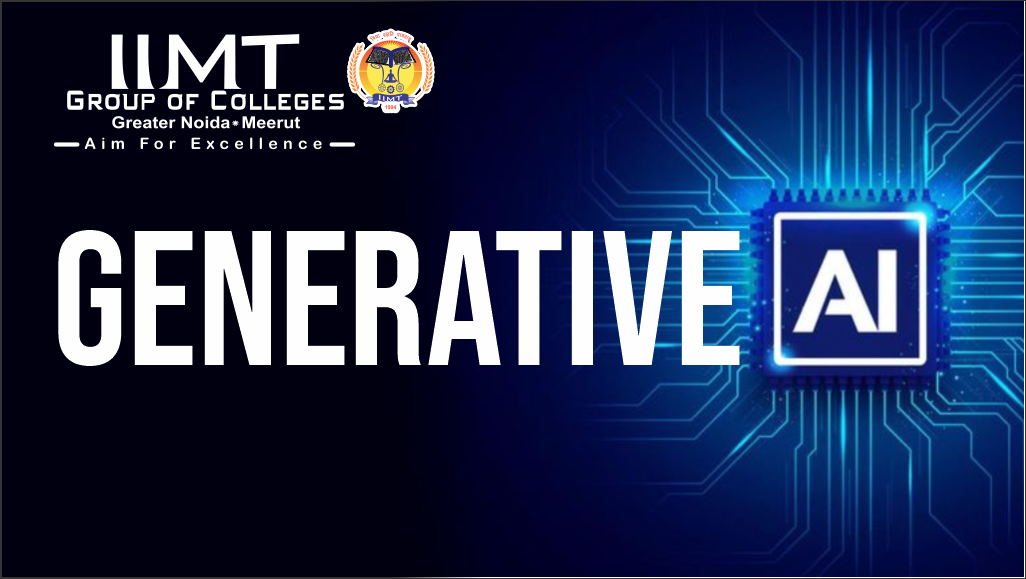Generative AI
 IImt College
IImt College
Understanding Generative AI
Generative AI refers to a class of artificial intelligence models designed to create new content, whether it be images, text, music, videos, or even code. Unlike traditional AI models that are primarily designed to recognize patterns or classify data, generative AI goes a step further by producing entirely new and original content based on the patterns it has learned from existing data. This revolutionary capability has led to significant advancements in fields such as creative arts, business, and technology, opening up new possibilities for innovation and automation.
How Generative AI Works
At the core of generative AI are machine learning models, particularly deep learning models such as Generative Adversarial Networks (GANs), Variational Autoencoders (VAEs), and Transformer-based models (e.g., GPT-3). These models are trained on vast datasets and learn to replicate the underlying structure and style of the data they’ve been exposed to. For example, a generative AI model trained on a dataset of paintings could learn to produce entirely new artwork that mirrors the styles and techniques in the training data.
1. Generative Adversarial Networks (GANs)
GANs consist of two neural networks: a generator and a discriminator. The generator creates synthetic data, while the discriminator evaluates how realistic it is. The two networks engage in a "game" where the generator tries to fool the discriminator into believing its generated content is real, and the discriminator works to distinguish between real and fake data. This adversarial process results in the generation of highly realistic data, such as images or audio.
2. Variational Autoencoders (VAEs)
VAEs are another type of generative model, but they work by encoding data into a lower-dimensional latent space and then decoding it to reconstruct the original data. This approach is useful for tasks like image generation or denoising. The model learns the probability distribution of the data and can generate new samples by sampling from this distribution.
3. Transformer-based Models
Transformer models like OpenAI’s GPT-3 and GPT-4 represent a different approach to generative AI. These models are designed to process and generate sequential data, such as text, by learning complex relationships between words and sentences. By training on vast amounts of text, they can generate human-like responses, write essays, produce code, and even compose poetry or music.
Applications of Generative AI
Generative AI has already begun to make a profound impact in a wide range of industries. Some of the most notable applications include:
1. Content Creation
In the world of content creation, generative AI has unlocked new possibilities for writers, artists, and designers. Tools like ChatGPT (text generation) and DALL·E (image generation) allow users to quickly generate high-quality content with minimal effort. These tools are used to write articles, generate creative stories, design logos, or even create entirely new digital artwork. In the music industry, AI models can compose original songs, complete with melodies and lyrics, in a variety of genres.
2. Marketing and Advertising
Generative AI is also transforming marketing strategies by enabling personalized content generation at scale. Marketers can use AI to create custom advertisements, social media posts, or even email campaigns that are tailored to individual preferences. AI-driven content generation allows businesses to quickly adapt to market trends and customer needs, enhancing engagement and customer loyalty.
3. Healthcare
In healthcare, generative AI is being used to design new drugs, create personalized treatment plans, and even generate synthetic medical data for research purposes. AI models can predict molecular structures or simulate how different compounds might interact, streamlining the drug discovery process. In diagnostics, AI can generate synthetic medical images to help train radiologists or develop new techniques for analyzing medical data.
4. Entertainment and Media
The entertainment industry has embraced generative AI for creating visual effects, scriptwriting, video game design, and animation. AI tools can generate realistic environments, characters, and dialogue, significantly reducing the time and cost associated with traditional production processes. In film, AI is also used to enhance post-production work, such as creating deepfake videos or improving visual fidelity in CGI.
Ethical Considerations and Challenges
While generative AI offers tremendous potential, it also raises ethical and practical concerns. The ability to create hyper-realistic content, including deepfakes (fake videos or images), has led to fears about misinformation, privacy violations, and manipulation. Ensuring that generative AI is used responsibly requires the development of ethical guidelines, transparency, and safeguards against misuse.
Another challenge is the potential for bias in AI models. Since generative AI learns from historical data, it may inherit biases present in that data, leading to the creation of content that reinforces harmful stereotypes or discriminatory practices. Researchers are working on methods to mitigate bias and ensure that generative models are fair and equitable.
The Future of Generative AI
As generative AI continues to evolve, its capabilities will only expand. Future advancements may include AI models capable of generating even more complex forms of content, such as virtual environments, interactive experiences, or personalized media. The integration of AI with other emerging technologies, such as augmented reality (AR) and virtual reality (VR), could enable entirely new forms of immersive storytelling and digital interaction.
Ultimately, generative AI holds the promise of revolutionizing how we create and interact with content, transforming industries, and democratizing creativity. However, as with any technological advancement, it will require careful oversight and regulation to ensure its benefits are realized ethically and responsibly.
For students interested in technology and innovation, pursuing an artificial intelligence College in Noida is an exciting and forward-thinking alternative.
Subscribe to my newsletter
Read articles from IImt College directly inside your inbox. Subscribe to the newsletter, and don't miss out.
Written by
